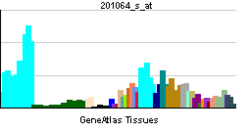- PABPC4
-
Poly(A) binding protein, cytoplasmic 4 (inducible form) 
PDB rendering based on 1cvj.Available structures PDB 1cvj Identifiers Symbols PABPC4; APP-1; APP1; FLJ43938; PABP4; iPABP External IDs OMIM: 603407 MGI: 2385206 HomoloGene: 37855 GeneCards: PABPC4 Gene Gene Ontology Molecular function • nucleotide binding
• RNA binding
• protein binding
• poly(A) RNA binding
• poly(U) RNA binding
• poly(C) RNA bindingCellular component • cytoplasm
• ribonucleoprotein complexBiological process • RNA processing
• RNA catabolic process
• translation
• blood coagulationSources: Amigo / QuickGO RNA expression pattern 
More reference expression data Orthologs Species Human Mouse Entrez 8761 230721 Ensembl ENSG00000090621 ENSMUSG00000011257 UniProt Q13310 n/a RefSeq (mRNA) NM_001135653.1 NM_130881 RefSeq (protein) NP_001129125.1 NP_570951 Location (UCSC) Chr 1:
40.03 – 40.04 MbChr 4:
122.94 – 122.98 MbPubMed search [1] [2] Polyadenylate-binding protein 4 is a protein that in humans is encoded by the PABPC4 gene.[1][2]
Poly(A)-binding proteins (PABPs) bind to the poly(A) tail present at the 3-prime ends of most eukaryotic mRNAs. PABPC4 or IPABP (inducible PABP) was isolated as an activation-induced T-cell mRNA encoding a protein. Activation of T cells increased PABPC4 mRNA levels in T cells approximately 5-fold. PABPC4 contains 4 RNA-binding domains and proline-rich C terminus. PABPC4 is localized primarily to the cytoplasm. It is suggested that PABPC4 might be necessary for regulation of stability of labile mRNA species in activated T cells. PABPC4 was also identified as an antigen, APP1 (activated-platelet protein-1), expressed on thrombin-activated rabbit platelets. PABPC4 may also be involved in the regulation of protein translation in platelets and megakaryocytes or may participate in the binding or stabilization of polyadenylates in platelet dense granules.[2]
Interactions
PABPC4 has been shown to interact with PHLDA1.[3]
References
- ^ Feral C, Mattei MG, Pawlak A, Guellaen G (Nov 1999). "Chromosomal localization of three human poly(A)-binding protein genes and four related pseudogenes". Hum Genet 105 (4): 347–53. doi:10.1007/s004390051113. PMC 1865476. PMID 10543404. http://www.pubmedcentral.nih.gov/articlerender.fcgi?tool=pmcentrez&artid=1865476.
- ^ a b "Entrez Gene: PABPC4 poly(A) binding protein, cytoplasmic 4 (inducible form)". http://www.ncbi.nlm.nih.gov/sites/entrez?Db=gene&Cmd=ShowDetailView&TermToSearch=8761.
- ^ Hinz, T; Flindt S, Marx A, Janssen O, Kabelitz D (May. 2001). "Inhibition of protein synthesis by the T cell receptor-inducible human TDAG51 gene product". Cell. Signal. (England) 13 (5): 345–52. doi:10.1016/S0898-6568(01)00141-3. ISSN 0898-6568. PMID 11369516.
Further reading
- Maruyama K, Sugano S (1994). "Oligo-capping: a simple method to replace the cap structure of eukaryotic mRNAs with oligoribonucleotides". Gene 138 (1–2): 171–4. doi:10.1016/0378-1119(94)90802-8. PMID 8125298.
- Yang H, Duckett CS, Lindsten T (1996). "iPABP, an inducible poly(A)-binding protein detected in activated human T cells". Mol. Cell. Biol. 15 (12): 6770–6. PMC 230930. PMID 8524242. http://www.pubmedcentral.nih.gov/articlerender.fcgi?tool=pmcentrez&artid=230930.
- Houng AK, Maggini L, Clement CY, Reed GL (1997). "Identification and structure of activated-platelet protein-1, a protein with RNA-binding domain motifs that is expressed by activated platelets". Eur. J. Biochem. 243 (1–2): 209–18. doi:10.1111/j.1432-1033.1997.0209a.x. PMID 9030741.
- Suzuki Y, Yoshitomo-Nakagawa K, Maruyama K, et al. (1997). "Construction and characterization of a full length-enriched and a 5'-end-enriched cDNA library". Gene 200 (1–2): 149–56. doi:10.1016/S0378-1119(97)00411-3. PMID 9373149.
- Hoshino S, Imai M, Kobayashi T, et al. (1999). "The eukaryotic polypeptide chain releasing factor (eRF3/GSPT) carrying the translation termination signal to the 3'-Poly(A) tail of mRNA. Direct association of erf3/GSPT with polyadenylate-binding protein". J. Biol. Chem. 274 (24): 16677–80. doi:10.1074/jbc.274.24.16677. PMID 10358005.
- Hinz T, Flindt S, Marx A, et al. (2001). "Inhibition of protein synthesis by the T cell receptor-inducible human TDAG51 gene product". Cell. Signal. 13 (5): 345–52. doi:10.1016/S0898-6568(01)00141-3. PMID 11369516.
- Strausberg RL, Feingold EA, Grouse LH, et al. (2003). "Generation and initial analysis of more than 15,000 full-length human and mouse cDNA sequences". Proc. Natl. Acad. Sci. U.S.A. 99 (26): 16899–903. doi:10.1073/pnas.242603899. PMC 139241. PMID 12477932. http://www.pubmedcentral.nih.gov/articlerender.fcgi?tool=pmcentrez&artid=139241.
- Li J, Hawkins IC, Harvey CD, et al. (2003). "Regulation of Alternative Splicing by SRrp86 and Its Interacting Proteins". Mol. Cell. Biol. 23 (21): 7437–47. doi:10.1128/MCB.23.21.7437-7447.2003. PMC 207616. PMID 14559993. http://www.pubmedcentral.nih.gov/articlerender.fcgi?tool=pmcentrez&artid=207616.
- Ota T, Suzuki Y, Nishikawa T, et al. (2004). "Complete sequencing and characterization of 21,243 full-length human cDNAs". Nat. Genet. 36 (1): 40–5. doi:10.1038/ng1285. PMID 14702039.
- Lehner B, Sanderson CM (2004). "A Protein Interaction Framework for Human mRNA Degradation". Genome Res. 14 (7): 1315–23. doi:10.1101/gr.2122004. PMC 442147. PMID 15231747. http://www.pubmedcentral.nih.gov/articlerender.fcgi?tool=pmcentrez&artid=442147.
- Colland F, Jacq X, Trouplin V, et al. (2004). "Functional Proteomics Mapping of a Human Signaling Pathway". Genome Res. 14 (7): 1324–32. doi:10.1101/gr.2334104. PMC 442148. PMID 15231748. http://www.pubmedcentral.nih.gov/articlerender.fcgi?tool=pmcentrez&artid=442148.
- Goehler H, Lalowski M, Stelzl U, et al. (2004). "A protein interaction network links GIT1, an enhancer of huntingtin aggregation, to Huntington's disease". Mol. Cell 15 (6): 853–65. doi:10.1016/j.molcel.2004.09.016. PMID 15383276.
- Gerhard DS, Wagner L, Feingold EA, et al. (2004). "The Status, Quality, and Expansion of the NIH Full-Length cDNA Project: The Mammalian Gene Collection (MGC)". Genome Res. 14 (10B): 2121–7. doi:10.1101/gr.2596504. PMC 528928. PMID 15489334. http://www.pubmedcentral.nih.gov/articlerender.fcgi?tool=pmcentrez&artid=528928.
- Rush J, Moritz A, Lee KA, et al. (2005). "Immunoaffinity profiling of tyrosine phosphorylation in cancer cells". Nat. Biotechnol. 23 (1): 94–101. doi:10.1038/nbt1046. PMID 15592455.
- Ong SE, Mittler G, Mann M (2005). "Identifying and quantifying in vivo methylation sites by heavy methyl SILAC". Nat. Methods 1 (2): 119–26. doi:10.1038/nmeth715. PMID 15782174.
- Ewing RM, Chu P, Elisma F, et al. (2007). "Large-scale mapping of human protein–protein interactions by mass spectrometry". Mol. Syst. Biol. 3 (1): 89. doi:10.1038/msb4100134. PMC 1847948. PMID 17353931. http://www.pubmedcentral.nih.gov/articlerender.fcgi?tool=pmcentrez&artid=1847948.
PDB gallery Butyrate response factor 1 • Fragile X mental retardation protein • Rev • hu paraneoplastic encephalomyelitis antigens • mRNA cleavage and polyadenylation factors (Cleavage and polyadenylation specificity factor, Cleavage stimulation factor) • host factor 1 protein • Aconitase (ACO1, ACO2) • nuclear factor 90 proteins (ILF2) • Poly(A)-binding protein (PABPC1, PABPC3, PABPC4) • polypyrimidine tract-binding protein • ribonucleoprotein • RNA cap-binding protein (Cap binding complex, EIF4E, EIF4G1) • SMN complex proteins (SMN1, SMN2, DDX20)B bsyn: dna (repl, cycl, reco, repr) · tscr (fact, tcrg, nucl, rnat, rept, ptts) · tltn (risu, pttl, nexn) · dnab, rnab/runp · stru (domn, 1°, 2°, 3°, 4°) Categories:- Human proteins
- Chromosome 1 gene stubs
Wikimedia Foundation. 2010.

